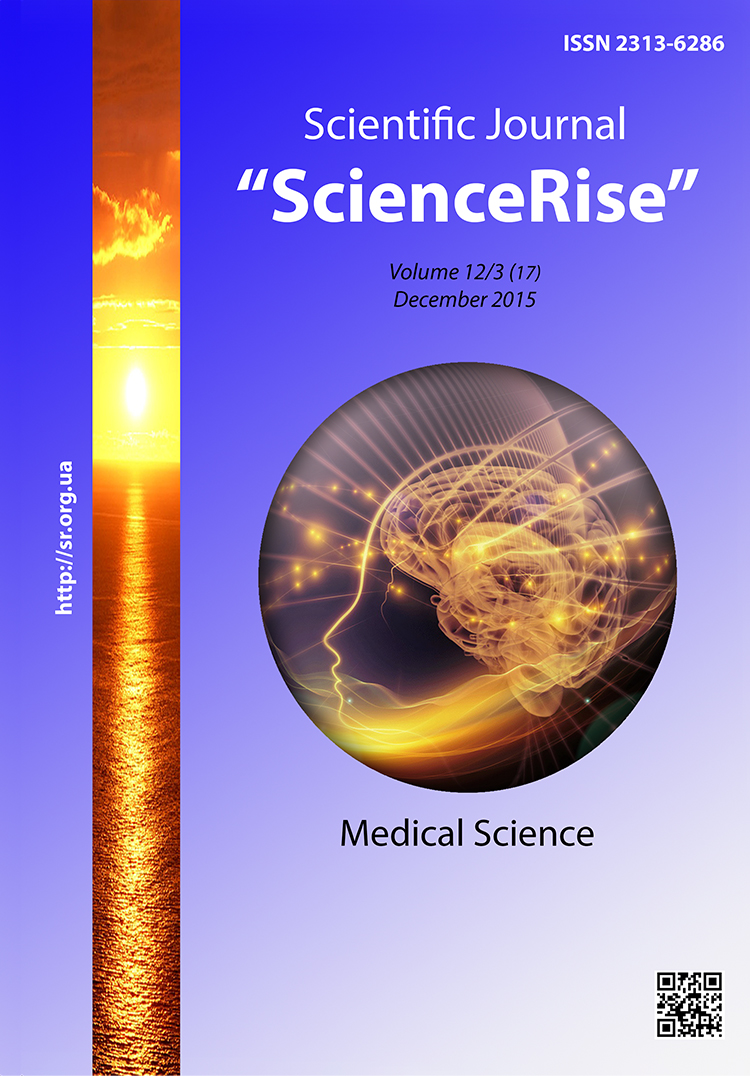Залежність ефективності тромболітичної терапії при ішемічному інсульті від клініко-параклінічних предикторів
DOI :
https://doi.org/10.15587/2313-8416.2015.56428Mots-clés :
Актилізе, альтеплаза, тромболітична терапія, інфаркт мозку, ішемічний інсульт, предиктори ефективностіRésumé
Метою роботи є оцінка інформативності ряду клініко-параклінічних предикторів у прогнозуванні результатів ефективності тромболітичної терапії в найгострішому періоді ішемічного інсульту, з подальшим визначенням найбільш значимих у досягненні найменшого неврологічного дефіциту. Встановлено, що тромболітична терапія ішемічного інсульту має починатися якнайшвидше (по можливості вже у відділенні комп’ютерної томографії) з метою отримання максимальної ефективностіRéférences
Kuznetsov, A. N. (2004). Tserebralnaia embolyia: proshloe, nastoiashchee, budushchee problemy. Nevroloh. Zhurnal, 5, 4–11.
Shulha, O. D. (2008). Faktory, shcho vplyvaiut na perebih ta rezultat ishemichnoho insultu. Mizhnarodnyi nevrolohichnyi zhurnal, 6, 27–30. Available at: http://www.mif-ua.com/archive/article/7513
Husev, E. Y., Skvortsova, V. Y. (2001). Ishemyia holovnoho mozgha. Moscow: Medytsyna, 325. Available at: https://vk.com/doc29370700_301660821?hash=48ef68632745343646&dl=f38ebe7db2d6f4c773
Vereshchahyn, N., Pyradov, M. (2007). Intensyvnaia terapyia ostrykh narushenyi mozghovoho krovoobrashchenyia. Medytsyna neotlozhnykh sostoianyi, 2, 92–97. Available at: http://www.emergencymed.org.ua/j_pdf/2007_2_92_97.pdf
Clark, W. M., Williams, B. J., Selzer, K. A., Zweifler, R. M., Sabounjian, L. A., Gammans, R. E. (1999). A Randomized Efficacy Trial of Citicoline in Patients With Acute Ischemic Stroke. Stroke, 30 (12), 2592–2597. doi: 10.1161/01.str.30.12.2592
Chaturvedi, S., Bertasio, B., Femino, L. (1998). Emergency physician attitudes toward thrombolytic therapy in acute stroke. Journal of Stroke and Cerebrovascular Diseases, 7 (6), 442–445. doi: 10.1016/s1052-3057(98)80129-8
Karger, S. (2008). Guidelines for management of ischaemic stroke and transient ischaemic attack 2008. Cerebrovascular diseases, 25 (5), 457–507. doi: 10.1159/000131083
Yavorska, V. O., Bodnar, O. B., Hrebeniuk, A. V. et. al (2013). Suchasni pryntsypy diahnostyky ta likuvannia khvorykh iz hostrym ishemichnym insultom ta TIA. Novyny medytsyny i farmatsii, 438, 55–78.
Shkliaieva, O. P. (2013). Osoblyvosti perebihu arterialnoi hipertenzii v hostromu periodi ishemichnoho insultu u khvorykh z fibryliatsiieiu. Vol. 22. NMAPO im. P. L. Shupyka, 201–207. Available at: http://nbuv.gov.ua/j-pdf/Znpsnmapo_2013_22(2)__33.pdf
Zozulia, Y. S., Bobrova, V. Y. (2000). Osobennosty vosstanovlenyia narushennykh funktsyi u bolnykh mozghovymy insultamy. Ukrainskyi visnyk psykhonevrolohii, 8, 28–29.
Panteleienko, L. V., Sokolova, L. I. (2010) Funktsionalnyi vykhid i yakist zhyttia cherez 6 misiatsiv pislia podii u khvorykh, shcho perenesly ishemichnyi insult, zalezhno vid stati. Medytsyna, 34, 56–68.
Kozolkin, O. A., Kuznietsov, A. A., Ruban, K. S. (2012). Kliniko-paraklinichna kharakterystyka ta prohnozuvannia naslidku hostroho periodu mozkovoho ishemichnoho supratentorialnoho insultu za naiavnosti stresovoi hiperhlikemii bez tsukrovoho diabetu. Mizhnarodnyi nevrolohichnyi zhurnal, 5, 61–67.
Murashko, N. K., Shkliaieva, O. P. (2013). Kliniko-nevrolohichni osoblyvosti rozvytku ishemichnoho insultu u khvorykh z fibryliatsiieiu peredserd. Likar. Sprava, 1, 77–82.
Pashkovska, N. V., Pashkovskyi, V. M. (2012). Suchasni pidkhody do likuvannia ta profilaktyky ishemichnoho insultu u khvorykh na tsukrovyi diabet. Praktychna anhiolohiia, 3, 24–30.
Dziak, L. A., Tsurkalenko, E. S. (2009). Insult u molodykh patsyentov. Zdorovia Ukrainy, 5/1, 12–15. Available at: http://health-ua.com/article/3622.html
Ingalsbe, G. (2015). Effect of Treatment Delay, Age, and Stroke Severity on the Effects of Intravenous Thrombolysis with Alteplase for Acute Ischaemic Stroke: A Meta-analysis of Individual Patient Data from Randomized Trials. The Journal of Emergency Medicine, 48 (5), 650. doi: 10.1016/j.jemermed.2015.03.037
Hodgson, C. S. (2007). To FAST or Not to FAST? Stroke, 38 (10), 2631–2632. doi: 10.1161/strokeaha.107.488809
Ozdemir, O., Giray, S., Arlier, Z., Baş, D. F., Inanc, Y., Colak, E. (2015). Predictors of a Good Outcome after Endovascular Stroke Treatment with Stent Retrievers. The Scientific World Journal, 2015, 1–9. doi: 10.1155/2015/403726
Šaňák, D., Herzig, R., Zapletalová, J., Horák, D., Král, M., Školoudík, D. et. al (2011). Predictors of good clinical outcome in acute stroke patients treated with intravenous thrombolysis. Acta Neurologica Scandinavica, 123 (5), 339–344. doi: 10.1111/j.1600-0404.2010.01401.x
Téléchargements
Publié-e
Numéro
Rubrique
Licence
(c) Tous droits réservés Іванна Михайлівна Мельнічек, Анжеліка Володимирівна Паєнок, Галина Михайлівна Пришляк 2015

Cette œuvre est sous licence Creative Commons Attribution 4.0 International.
Our journal abides by the Creative Commons CC BY copyright rights and permissions for open access journals.
Authors, who are published in this journal, agree to the following conditions:
1. The authors reserve the right to authorship of the work and pass the first publication right of this work to the journal under the terms of a Creative Commons CC BY, which allows others to freely distribute the published research with the obligatory reference to the authors of the original work and the first publication of the work in this journal.
2. The authors have the right to conclude separate supplement agreements that relate to non-exclusive work distribution in the form in which it has been published by the journal (for example, to upload the work to the online storage of the journal or publish it as part of a monograph), provided that the reference to the first publication of the work in this journal is included.

